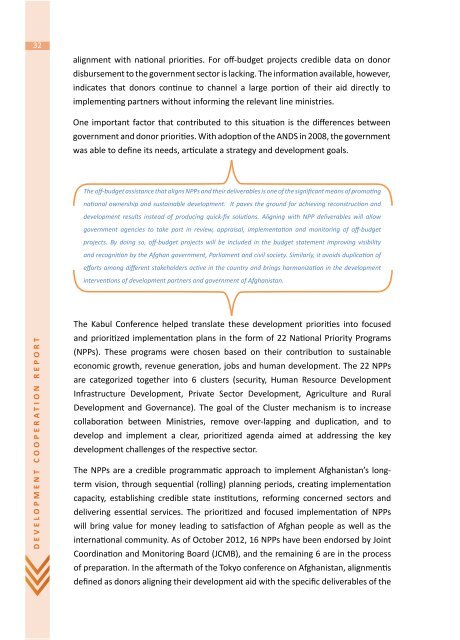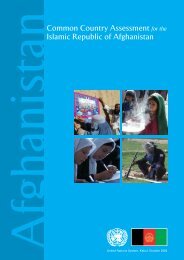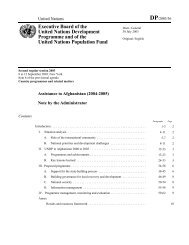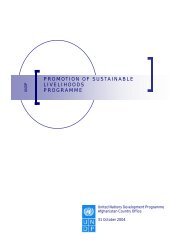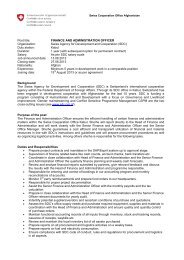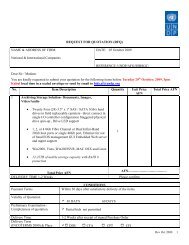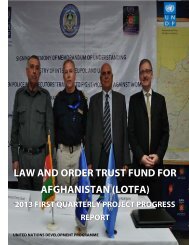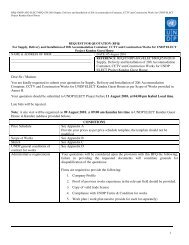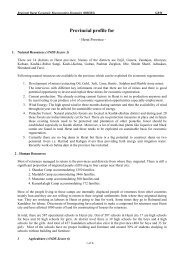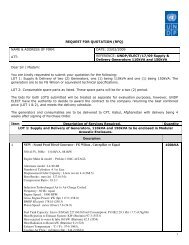Development Cooperation Report 2012 - UNDP Afghanistan
Development Cooperation Report 2012 - UNDP Afghanistan
Development Cooperation Report 2012 - UNDP Afghanistan
You also want an ePaper? Increase the reach of your titles
YUMPU automatically turns print PDFs into web optimized ePapers that Google loves.
32<br />
alignment with national priorities. For off-budget projects credible data on donor<br />
disbursement to the government sector is lacking. The information available, however,<br />
indicates that donors continue to channel a large portion of their aid directly to<br />
implementing partners without informing the relevant line ministries.<br />
One important factor that contributed to this situation is the differences between<br />
government and donor priorities. With adoption of the ANDS in 2008, the government<br />
was able to define its needs, articulate a strategy and development goals.<br />
The off-budget assistance that aligns NPPs and their deliverables is one of the significant means of promoting<br />
national ownership and sustainable development. It paves the ground for achieving reconstruction and<br />
development results instead of producing quick-fix solutions. Aligning with NPP deliverables will allow<br />
government agencies to take part in review, appraisal, implementation and monitoring of off-budget<br />
projects. By doing so, off-budget projects will be included in the budget statement improving visibility<br />
and recognition by the Afghan government, Parliament and civil society. Similarly, it avoids duplication of<br />
efforts among different stakeholders active in the country and brings harmonization in the development<br />
interventions of development partners and government of <strong>Afghanistan</strong>.<br />
DEVELOPMENT COOPERATION REPORT<br />
The Kabul Conference helped translate these development priorities into focused<br />
and prioritized implementation plans in the form of 22 National Priority Programs<br />
(NPPs). These programs were chosen based on their contribution to sustainable<br />
economic growth, revenue generation, jobs and human development. The 22 NPPs<br />
are categorized together into 6 clusters (security, Human Resource <strong>Development</strong><br />
Infrastructure <strong>Development</strong>, Private Sector <strong>Development</strong>, Agriculture and Rural<br />
<strong>Development</strong> and Governance). The goal of the Cluster mechanism is to increase<br />
collaboration between Ministries, remove over-lapping and duplication, and to<br />
develop and implement a clear, prioritized agenda aimed at addressing the key<br />
development challenges of the respective sector.<br />
The NPPs are a credible programmatic approach to implement <strong>Afghanistan</strong>’s longterm<br />
vision, through sequential (rolling) planning periods, creating implementation<br />
capacity, establishing credible state institutions, reforming concerned sectors and<br />
delivering essential services. The prioritized and focused implementation of NPPs<br />
will bring value for money leading to satisfaction of Afghan people as well as the<br />
international community. As of October <strong>2012</strong>, 16 NPPs have been endorsed by Joint<br />
Coordination and Monitoring Board (JCMB), and the remaining 6 are in the process<br />
of preparation. In the aftermath of the Tokyo conference on <strong>Afghanistan</strong>, alignmentis<br />
defined as donors aligning their development aid with the specific deliverables of the


